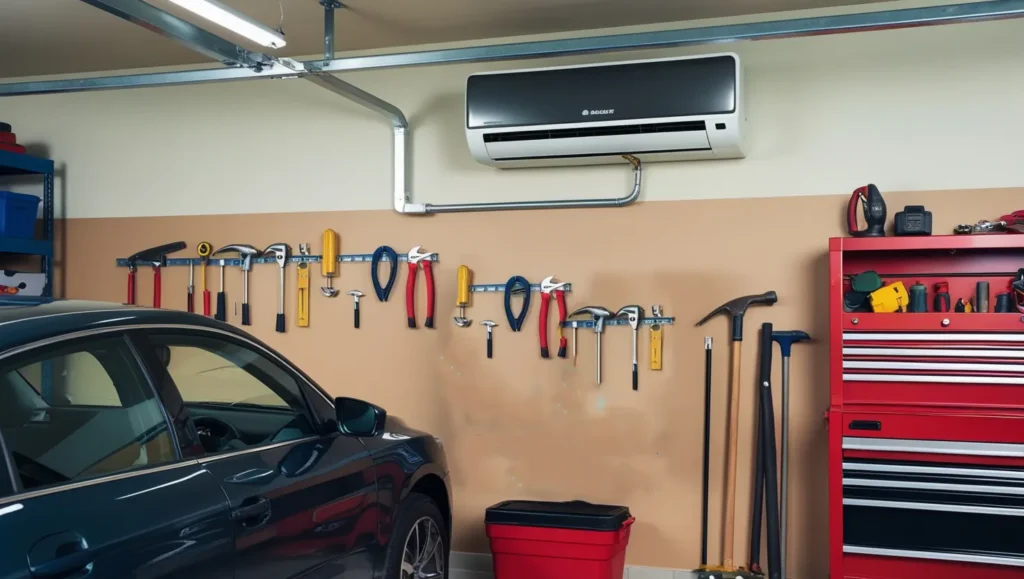mini split air-conditioner for the garage
When it comes to air conditioner requirements in garage areas, the mini split will be the best option. It’s easy to install, cost-friendly, and reliable. There are other air conditioner systems, but why do we choose a mini split AC over others?

Because each system has its own purpose. Mini split air conditioners are made for small areas like house rooms, garages, etc. When it comes to shopping malls, commercial spaces, and bungalow areas, we use VRF systems. In industrial spaces, or if the project requires more than 1,000 tons of air conditioning capacity, we prefer a chilled water air conditioning system.
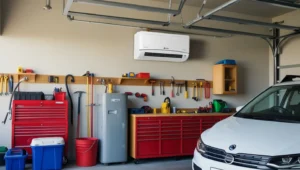
Now, for a garage area, the air conditioner requirement will be a maximum of 2/5 tons or more, depending on the room size. For this kind of area, if we try to use VRF or chilled water air conditioning systems, then the cost will increase by 10 to 50 percent extra, which is illogical. If you get what you need for $1,000, then why would you invest $5,000 or $10,000 for the same service?
That’s why, in the beginning, I said a mini split is the best option for a garage area.
How to Get the Right Capacity (Ton/KW/BTU) Based on Garage Size:
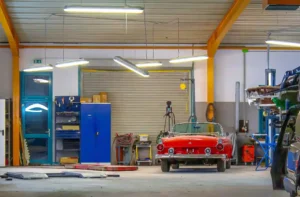
Before you buy an LG, Midea, Daikin, or other brand’s mini split AC for your place, you must know the BTU/ton/kW requirement for your garage area. Well, we consider lots of things before requiring an air conditioner. But you don’t need to be worried about it, because the seller will recommend and provide all the information you need. If you still have the curiosity to know about it, then here I have explained the 7 things you need to consider before selecting the require capacity.
When it comes to selecting the right capacity for your garage, there are many things you need to check, like:

- Garage Volume (m³)
- Air Changes Per Hour (ACH).
- room temperature. (ΔT)
- Compute Infiltration Heat Load.
- Heat generating source.
- Climate Change issue.
- Insulation factor of the garage room.
The reason we consider these factors before BTU selection is because your car, bike, or other machines generate heat. If you keep one car in your garage, it will generate less heat. In this case, the machine factor will be 1.0.
1. First, we need to calculate the Garage Volume (m³):
Volume = Length (m) × Width (m) × Height (m).
Example: 6m × 4m × 3m = 72 m³.
2. Now we need to figure out the garage area’s Air Changes Per Hour (ACH):
Garages lose massive heat/cooling from door openings. Use these ACH values: So, if you open the window of the garage then the ACH will be 0.5. (Low ACH)
If the garage, door, and window are used moderately and a good amount of fresh air passes through it then the ACH will be 2. (Medium ACH)
If the garage has the perfect amounts of doors and windows & through this, the place has a good fresh air supply then the ACH will be 5. (High ACH)
3. We need to know about your room temperature. (ΔT):
ΔT = Desired indoor temp (°C) Outdoor temp (°C).
Example: For cooling in a heatwave (indoor 21°C, outdoor 35°C): ΔT = 14°C

4. Compute Infiltration Heat Load:
kW = Volume × ACH × ΔT × 0.00034.
Example: 72 m³ × 2 ACH × 14°C × 0.00034 ≈ 0.69 kW.
5. Heat generating source:
It means how many machines, cars, & tools will be in the garage. This information is important because they all produce heat.
Tools (If the garage has a drill machine = 0.75 kW).
Fridge (0.1–0.3 kW).
Lighting (100W LED = 0.1 kW).
Example total: 0.75 + 0.3 + 0.1 = 1.15 kW.
6.Adjust for Climate:
Climate Change is the most important thing to notice before we think of getting a mini-split air-conditioner.
1.5: Extreme heat (Arab, African, Asian countries)
1.2: Hot summers (Spain, Florida).
1.0: Temperate (UK, New Zealand).
0.8: Cool climates (Russia, Canada, Scandinavia, Italy).
7. Insulation factor of the garage room:
Basically, it is about the insulation factor of the garage area. The inside temperature depends a lot on the insulation factor. In summer, if the insulation factor is poor than inside temperature will get high. Which required a high-capacity air-conditioner. Insulation factor is important, because in a poorly insulated area like a glass room, if we use an AC on a very high setting, then due to condensation, you will see water on the glass.
0.7: if the garage is Well-insulated
1.0: Average-Insulated
1.3: Poor- Insulated

The required capacity of the air conditioner you need is,
= [(Volume × ACH × ΔT × 0.00034) + Heat Sources] × Climate Factor × Insulation Factor
= [(72 × 2 × 14 × 0.00034) + 1.15] × 1.2 × 1.3
= [0.69 + 1.15] × 1.56 ≈ 2.88 kW.
= Round up to 3.5 kW (allows a 20% safety margin).
Installation Process, Energy Efficiency, and Cost of Mini Split:
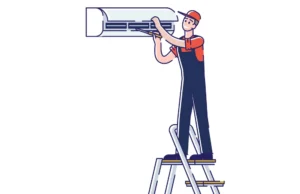
The installation process of a mini split AC is very simple. First, you need to install the indoor unit and outdoor unit. After that, connect the communication cable and copper pipe with insulation, complete the flushing, pressure test, and refrigerant charge work, then complete the electrical connection of your air conditioner. That’s it! Now you can turn on your AC. Within 3 to 4 hours, an expert technician can install it. For more details, read my blog, “The Installation Process of Mini Split.”
Mini split ACs are good for efficiency. There are two kinds of mini splits: convertible and non-convertible. I suggest choosing a convertible mini split AC because when your room is cool enough, the compressor will turn off. In convertible ACs, the compressor turns off/on as per room requirement. This is how it saves electricity.
For a personal garage, the cost will be a maximum of 1–1.5 thousand dollars, depending on your garage size.
Maintenance, Ventilation, and Air Quality:
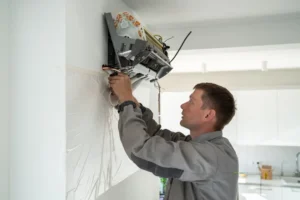
How long you can use a mini split AC depends on the installation process. After installation, you need to maintain it properly. Every 4 months, you need to clean the air filter because it gets jammed, and if you don’t clean it, the cooling quality and efficiency will become poor.
For ventilation, a mini-split can’t play any role in your garage area because they don’t bring cold air from outside. They just cool your room temperature constantly. Your air quality depends on the ventilation. For ventilation, you need to install a fresh air duct line with a fan and also an exhaust line. You will need an exhaust line to pass the car’s smoke outside. By doing this, your space will get fresh air, and the air quality will also improve.

